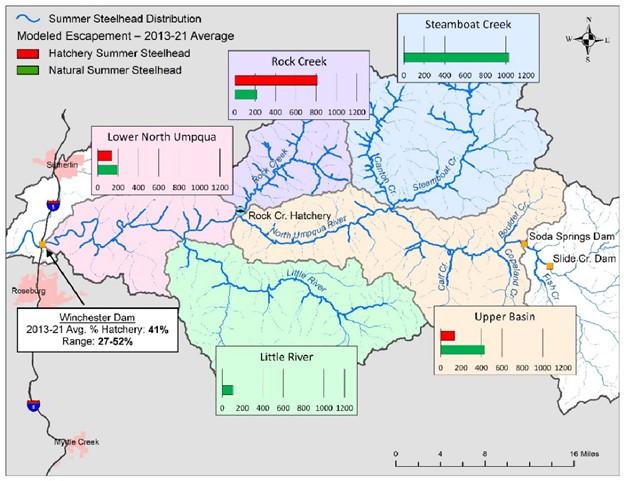North Umpqua Summer Steelhead Hatchery Program Update
By Ken Carloni
Those of you who are following Umpqua Watersheds’ reports and recent newspaper articles may be concerned about the status of the North Umpqua summer steelhead hatchery program. UW has been working with a coalition of conservation organizations including the Native Fish Society, the Steamboaters, the North Umpqua Foundation, the Conservation Angler, Pacific Rivers, and Trout Unlimited to urge the Oregon Fish and Wildlife Commission (the body that develops policy for the Oregon Dept. of Fish and Wildlife) to end the summer steelhead hatchery program at Rock Creek.
Months of organizing field tours and educating Commission members finally paid off when on April 22nd, the Commission did just that. Although ODF&W recommended maintaining the program, the Commission listened to the science presented by our team and directed their staff to end the program. Our celebration, however, was short-lived – soon after that decision, Douglas County, the Umpqua Fisheries Enhancement Derby, and a fishing guide filed for an injunction to halt the permanent termination of the program.
Our attorneys quickly filed a Petition to Intervene that argued that the Commissioner’s decision is supported by science and is consistent with agency rules. We were very confident that science would prevail again, but judge Daniel Wren denied our petition, finding that our organizations (that have advocated for wild fish for decades) did not have a compelling interest in the case!
Unfortunately, the lawyer for the Oregon Dept. of Justice (representing the Commission) only argued arcane points of law (“jurisdiction” and the meaning of an “order”), so not one single argument based on biology was heard by the judge. Our attorneys had to sit by and watch the DoJ fail to address the plaintiffs’ meritless claims. The next day, the gates were opened at Rock Creek, and juvenile summer steelhead began entering the North Umpqua.
Many are asking what would have happened to those fish if the judge had allowed us to join the DoJ in arguing the case. Would they have been “wasted”? Quite the opposite. They would have been released into Galesville and/or Cooper Creek Reservoir where they would have developed into non-migrating rainbow trout. A far higher percentage would have been caught by anglers in those fisheries than in the North Umpqua where they must now survive out-migration, ocean conditions, and the return to the upper North Umpqua.
Still others are questioning our coalition’s arguments for ending the summer steelhead hatchery program in the first place. There are many reasons for our position. Briefly:
- Out-migrating hatchery smolts compete for food and other resources with wild fish as they make their way to the ocean, and also prey on native juveniles. Then wild fish must continue to compete in the ocean, and on their return journey.
- When raised in close quarters in concrete tanks, hatchery fish are prone to a myriad of diseases that they can spread to wild fish that they come in contact with.
- Over a decade of research has documented the poorer productivity of hatchery fish compared to wild stock. The behaviors that lead to a decrease in reproductive success of hatchery fish are “epigenetic” [see my article in UW’s spring 2022 newsletter] and persist for at least two more generations. The offspring of crosses between hatchery and wild fish inherit this deficit and produce fewer offspring.
- Because of this last point, the ODF&W’s management plan calls for action if the percentage of hatchery originating spawners (pHOS) is over 10%. Figure 1. is sourced from an ODFW assessment of wild summer steelhead* and shows that this standard is violated in sub-basins through which returning spawners must navigate. Note that on average, 41% of the spawners that cross Winchester Dam are hatchery fish. Fortunately, the Steamboat/Canton Creek sub-basin is a wild steelhead stronghold that hatchery fish have not yet invaded. Little River has no hatchery component but produces few fish because of severe habitat degradation. Not surprisingly, Rock Creek is overwhelmingly dominated by hatchery fish. But even with these high pHOS levels, the ODF&W will not act in accordance with their management plan.
- In their analysis of hatchery impacts on wild summer steelhead*, the ODF&W concludes that because both wild and hatchery summer steelhead have declined, and river and ocean conditions have been sub-optimal, the precipitous decline in the North Umpqua wild summer run is due to degraded conditions in these habitats. While we disagree with this conclusion, for the sake of argument, let’s assume that this is true.

If it is all about river and ocean conditions, then summer steelhead populations are controlled by environmental factors that put an upper limit, or “carrying capacity”, on the combined population of wild and hatchery fish. So, adding more hatchery fish to the population will NOT result in more fish returning to spawn. Allowing naturally produced wild fish to avoid competition, disease, and genetic contamination from hatchery fish will increase their success so that ALL the fish that the environment can sustain will carry genes that best adapt summer steelhead to North Umpqua conditions.
The good news is that so far, the Commission’s decision to eliminate the summer steelhead program at Rock Creek still stands for the future. We will continue to urge the Fish and Wildlife Commission to follow the science and stand firm on their correct decision in the face of a completely politically-driven backlash.

